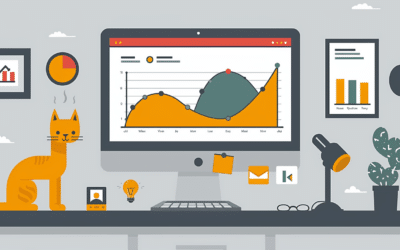The Beginner’s Guide to Blogging for Small Businesses: Essentials for Success
Embarking on the journey of blogging can be an exciting endeavor for small businesses looking to enhance their digital presence. As a beginner, you may feel overwhelmed with where to begin or uncertain about the potential benefits. Rest assured, starting a blog can be a powerful tool to connect with your audience and showcase your expertise. It’s a platform where you can share insights, news, and stories related to your business or industry. By providing valuable content, you can attract and engage customers, fostering a community around your brand.
Before crafting your first blog post, it’s essential to understand the basics and formulate a strategy. Selecting a niche that aligns with your business goals and audience interests is a critical first step. This focus will guide your content creation efforts and help you maintain consistency. Consider also the practical aspects such as choosing a blogging platform and domain name, which will serve as the foundation for your online voice. With the right setup and approach, your blog can be an effective channel to amplify your message and build meaningful relationships with your customers.
Laying the Foundation

To effectively start a blog for your small business, it’s essential to make the right decisions in the initial stages. Establish a solid foundation by choosing the appropriate platform, securing a domain, selecting a theme, and understanding the key technical aspects.
Choosing Your Blogging Platform
Your blogging platform is the backbone of your site; it’s where you’ll craft, manage, and publish your content. Popular Content Management Systems (CMS) like WordPress, Squarespace, and Wix provide user-friendly interfaces. WordPress is what we recommend because of its customization and robust SEO capabilities. Squarespace and Wix offer more design-oriented experiences with less technical setup and less control over your blog. With a self-hosted WordPress blog, you own everything.
Staking Your Claim: Domain and Hosting
To establish your blog, you’ll need a custom domain name and web hosting provider. Your domain is your online address, and hosting is where your site’s data is stored. Providers like SiteGround and WPEngine are known for their reliability and WordPress integration. Always opt for providers that offer strong security and regular updates. For domain names, we recommend NameCheap.
- Domain:
yourbusinessblog.com - Hosting Provider: Choose based on performance, support, and scalability.
Design Dynamics: Themes and Customization
Themes control the visual layout of your blog. Both free and premium themes offer various customization options. While WordPress provides access to thousands of themes and templates, platforms like Squarespace offer a more limited, yet highly curated selection. Consider if you’ll need a developer for coding or if you prefer to use drag-and-drop plugins for formatting. We recommend Astra or Divi as your theme.
- Choose a theme that aligns with your brand and is responsive on all devices.
- Utilize plugins to extend your site’s functionality.
Understanding the Technicalities
Comprehending basic technical elements, from widgets to plugins, ensures a smoother blogging journey. Familiarize yourself with basic SEO principles, security measures, and the platform’s content management system to maintain a functional blog. WordPress software, for instance, excels with an extensive plugin ecosystem that can bolster your SEO efforts.
- SEO: Optimize content using keywords, meta descriptions, and tags.
- Security: Implement SSL certificates and regular backups.
Setting Your Blogging Schedule
A consistent blogging schedule keeps you accountable and your audience engaged. Outline your calendar by planning your topics, time for content creation, and publishing frequency in advance. Remember, regular updates not only help with audience retention but are also favorable for SEO.
- Weekly: 1-2 posts (recommended for most small businesses).
- Monthly: Content planning and SEO assessment.
By carefully addressing each aspect of your blog’s foundation, you’re on the right path to becoming a trusted resource in your industry.
Content Is King
In the digital ecosystem of small business blogging, your blog content serves as the cornerstone of your online presence. Ethical keyword usage and delivering value through every blog post solidify your reputation as an expert in your niche.
Defining Your Niche and Audience
Identify your niche with precision; it’s the compass guiding your content strategy. Understanding your target audience is equally crucial. They are the ones you’re educating, inspiring, or entertaining. Research and analyze their preferences to align your blog content with their interests and needs.
Mastering Content Creation
Invest time and effort in crafting high-quality blog posts. Harness your passion for the subject to generate insightful content consistently. Writing should be clear and engaging, while relevant images can do wonders in breaking up text and illustrating points. Always remember, that every piece of content should add value to your audience.
Strategies for Engaging Titles and Headlines
Your title and headlines are the hook; make them count. They should be compelling and informative, offering a glimpse into the value your post holds. A well-thought-out meta description can also improve click-through rates from search results. It’s a brief yet powerful preview of what’s in store for the reader.
Optimizing for Success
To ensure the success of your small business blog, focus on search engine optimization (SEO) to boost your online visibility and use analytics to guide your strategy and content creation.
The Nuts and Bolts of SEO
SEO is crucial for enhancing your blog’s visibility and ensuring that it ranks well on search engines. Keyword research is foundational; you need to understand what potential customers are searching for. Start by identifying phrases related to your business that have a high search volume. Use resources like addressing client pain points to connect with your audience’s needs effectively.
On your WordPress blog, optimize your titles, headers, and content with these keywords. Remember, search engines favor content that establishes authority and trust. Consistent, quality blog posts that accurately address user questions will build your online presence over time.
- Make Use of WordPress Plugins: Implement SEO plugins that can help you optimize your content with little hassle.
- Internal Linking: Link to other posts on your blog to keep readers engaged and signal to search engines that your site is a hub of related content.
Leveraging Analytics and Tools
Analytics play a key part in optimizing your blog by providing insights into where your traffic is coming from and how users interact with your content. Regularly consult your analytics to understand which of your efforts are paying off and where there’s room for improvement.
- Track Progress: Use tools like Google Analytics to monitor your blog’s performance. Look at metrics such as page views, bounce rate, and conversion rate.
- Performance Improvements: Identify which posts are most popular and update them regularly to enhance their SEO performance.
By combining SEO best practices with a thorough analysis of your blog’s performance, you can refine your content strategy and ensure that your blog serves as a potent solution to your audience’s needs. Books and beginner’s guides to blogging can provide further in-depth information on optimizing your blog for success.
Marketing Your Blog
To successfully elevate your blog above the digital noise, you need to leverage targeted marketing channels and strategies that will drive organic traffic and foster engagement.
The Power of Social Media
Social media platforms are indispensable as a marketing tool for your small business blog. They aid in increasing your blog’s visibility and driving more traffic. Create rich content that resonates with your audience and encourages shares. Use bold calls to action and relevant hashtags to improve discoverability. Regularly engaging with your followers can help build a loyal community around your brand.
Harnessing the Right Marketing Strategies
To promote your blog, start by:
- Understanding your audience: Tailor your content to their interests and needs.
- Performing SEO: Optimize your blog posts for search engines to improve your online visibility.
- Networking: Connect with other bloggers and small businesses to foster relationships and backlinks.
By implementing these approaches, you’ll not only attract new readers but also retain existing ones. Consistent use of these techniques will help your blog become a meaningful part of your marketing repertoire.
Monetizing Your Efforts
Monetizing your blog is a strategic effort to turn your content and audience into a revenue stream. To see a return on your investment, it’s crucial to choose the right monetization avenues that align with your brand and market. A modest budget can blossom into a significant income when wisely managed.
Exploring Monetization Avenues
The journey to make money blogging starts with identifying diverse channels through which your business blog can generate income. Deciding on the most viable path depends on your market, audience, and what you’re willing to invest, both in terms of time and money.
- Advertisement & Sponsorships: You could earn money by featuring ads or sponsored content directly related to your business niche. Consider pay-per-click models or secure sponsorships with brands that resonate with your market.
- Affiliate Marketing: Through affiliate programs, earn a commission promoting products or services, getting paid each time your referrals lead to a sale.
- Selling Products or Services: Create and sell niche-specific offerings, like e-books, courses, or merchandise. Your blog lends credibility and acts as a powerful sales platform.
- Gated Content: Develop premium content and offer it through subscription models or one-time access fees. This can include webinars, in-depth guides, or exclusive articles.
Building a Memorable Brand
Your brand’s memorable factor directly influences its credibility. An authentic and distinctive identity captivates audiences and bolsters your monetization efforts.
- Consistency Across Content: Maintain a unified voice and visual style across all posts to establish and reinforce your brand identity.
- Engagement With Audience: Regular interaction with followers builds trust and loyalty. Happy customers often provide testimonials, which can boost your brand’s credibility.
- Unique Value Proposition: Clearly articulate what sets your blog apart. A unique perspective or specialized content can carve out a niche in a crowded market.
Remember, monetizing your blog is not instant. An upfront investment in quality content and marketing can lead to a steady income stream. Keep your focus on providing value, and the money will follow.
Maintaining and Growing

In blogging, the keys to success rest on your blog’s stability and your ability to reach and resonate with more readers. Regular maintenance ensures your platform remains secure and functional, while strategic expansion efforts can increase your visibility and authority in your niche.
Regular Maintenance and Security
Consistency in publishing content is crucial for keeping your audience engaged and driving organic traffic. By establishing a predictable schedule, you give readers a reason to return to your site, fostering trust and a sense of community. Regular updates to your blog are also essential for security. This includes updating the platform itself, plugins, and themes to protect against vulnerabilities.
- Engagement: Respond to comments and messages promptly.
- Education: Stay informed on the latest blogging best practices and incorporate them into your strategy.
- Security Updates: Implement a routine to regularly check for and apply necessary updates.
Expansion and Outreach
Expanding your blog involves cultivating value and authority. Off-site efforts such as guest posts or collaborations with established bloggers can direct new audiences back to your blog.
- Name Generator: Utilize tools to brainstorm creative, brandable blog names that are memorable and resonate with your target audience.
- Organic Traffic: Optimize content for search engines to improve your blog’s visibility and attract readers who are searching for topics you cover.
- Audience Engagement: Foster community by creating interactive content and encouraging readers to share their thoughts.
Expansion Strategies:
- Guest blogging on relevant sites
- Utilizing social media for content promotion
- Networking with other bloggers and industry experts
By focusing on both maintenance and growth, you position your blog to build lasting relationships with your audience and extend your reach to new readers.
Frequently Asked Questions
In this section, you’ll find straightforward answers to some frequently asked questions that can guide you through starting and maintaining a successful blog for your small business.
How can small business owners start a blog with no prior experience?
You can begin by selecting a user-friendly blogging platform and deciding on your blog’s focus. Utilize online tutorials or services to understand the basics of setting up and customizing your blog.
What are the initial steps to establish a successful blog for a small business?
First, define your target audience and create a content strategy that addresses their needs and interests. Then, choose a reliable hosting service and blog theme that reflects your small business’s brand.
What are the potential financial benefits of blogging for beginners in small businesses?
Blogging can boost your website’s search engine optimization, leading to increased traffic and potential sales. It can also establish your expertise, attracting new opportunities for monetization, such as sponsored content or affiliate marketing.
What type of content should small businesses focus on for their blogs?
Create content that provides value to your audience, such as how-to guides, industry insights, and product uses. Highlight stories that showcase your small business’s personality and values.
How frequently should a small business update its blog for optimal audience engagement?
Aim to post consistently, whether that’s weekly, biweekly, or monthly. Consistency helps keep your audience engaged and can improve your blog’s visibility online.
What are the best practices for small businesses to promote their blog and increase visibility?
Leverage social media platforms, email marketing, and partnerships to promote your blog. Engage with your audience by replying to comments and sharing user-generated content.



